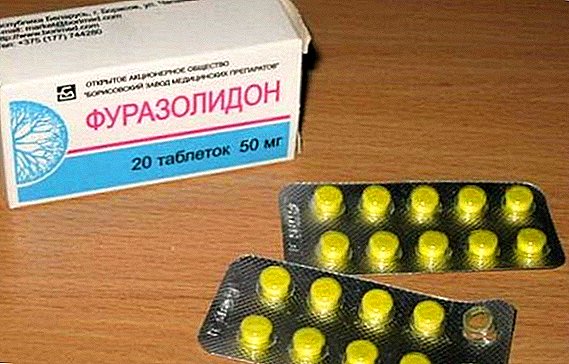 Breeding chickens - troublesome, especially at the stage of growing chickens. Their young body is not yet able to cope with many infections, so the likelihood of a particular viral disease always remains high. Antibiotics work best with these ailments. One of them is "Furazolidone". About him and will be discussed in our article.
Breeding chickens - troublesome, especially at the stage of growing chickens. Their young body is not yet able to cope with many infections, so the likelihood of a particular viral disease always remains high. Antibiotics work best with these ailments. One of them is "Furazolidone". About him and will be discussed in our article.
What is "Furazolidone"
"Furazolidone" is a drug that perfectly copes with various types of microbes. The active ingredient in it is 3- (5-nitro-2-furanyl) methylene-amino-2-oxazolidinone.  This synthetic compound belongs to the new class and differs from its predecessors in its broad spectrum of action and high efficiency.
This synthetic compound belongs to the new class and differs from its predecessors in its broad spectrum of action and high efficiency.
The form of release of the drug - tablets or granules for the preparation of suspensions, painted in yellow. It is applied inside, orally.
In addition to the active ingredient of the drug contains auxiliary: starch, lactose, tween-80, calcium stearate, sucrose.
Did you know? The male chicken is born from heavier eggs than the female chicken.
Therapeutic effect
The useful effect of the drug:
- tonic;
- bactericidal;
- bacteriostatic;
- increases the level of hemoglobin, protein, creatine;
- removes toxins remaining after the death of pathogenic microorganisms;
- increases the protective function of the body.

Against what
Disastrous medicine for the following bacteria:
- coccidia;
- bartonelle;
- histomon;
- trypanosomes;
- hexamity;
- salmonella;
- Trichomonas;
- Escherichia;
- Giardia;
- leptospira;
- shigella;
- causative agents of fungal infections.
Learn more about how to treat and prevent chick diseases.
Medication inhibits the development of pathogens that are sensitive to antibiotics and antimicrobials, slows down the process of addiction of bacteria to the drug. It has a detrimental effect on strains that have stopped responding to other antibiotics. 
Indications for use
"Furazolidone" is used to treat:
- parasitic infections;
- bacterial diseases;
- giardiasis;
- paratyphoid;
- protozoal enterocolitis;
- colpitis;
- coccidiosis;
- anaerobic diarrhea in chickens;
- trypanosomiasis;
- respiratory mycoplasmosis chickens;
- pullorosis;
- inflammation of the oviduct;
- urate diathesis in broilers;
- streptococcosis in chickens;
- enterocolitis;
- gastroenteritis;
- staphylococcal septicemia;
- bacillary type dysentery;
- dyspepsia.
Learn how to treat coccidiosis in poultry, chickens, broilers, and chickens.

Also, the drug is treated in chicks:
- infectious diarrhea;
- colisalmonellosis infection;
- problems with the urogenital system;
- feed toxicoinfections;
- intestinal disorders.
Used for prevention:
- salmonellosis;
- pasteurellosis;
- paratyphoid.
Important! The use of the drug in the postoperative period as an antibacterial agent is acceptable.
Instructions and dosage
Experts recommend: before starting a course of treatment with an antibiotic, young animals need to be fortified; also advised to drink birds glucose solution. 
There are two ways of delivering medicine to an animal:
- ground into powder pill mixed with food;
- the granules are dissolved in water.
Chicks are better to give a medical preparation dissolved in water. But it should be borne in mind that in the light of the medicine loses its antimicrobial effect. Therefore, it is necessary to carry out treatment in a dark place or to water each chick manually.
The dosage of the drug depends on the age and weight of the bird:
- daily chicks need 0.5 g of the drug per liter of water or 0.4 g per kilogram of feed (the course is not more than 14 days);
- chicks up to 7 days old with a prophylactic medication need 3 mg per kilogram of live weight;
- Aged 14 days is given a tablet per 100 ml of water.
If the young animals hit salmonellosis, then 4 kg of "Furazolidone" is given for a kilogram of chicken weight. The duration of the drug is 4-6 days.  To assimilate the medication was more effective, along with it, it is desirable to give vitamins of group B. A sufficient amount is contained in germinated cereals, whey, fish, bone and meat meal.
To assimilate the medication was more effective, along with it, it is desirable to give vitamins of group B. A sufficient amount is contained in germinated cereals, whey, fish, bone and meat meal.
Important! If it is necessary to treat all the poultry population at once, then first of all it is necessary to disinfect feeders and drinkers, and then give the drug, mixed with water or food.
Overdose
In case of overdose with a medical drug, the following occurs:
- weakness;
- apathy;
- vomiting;
- diarrhea;
- intense thirst;
- convulsions;
- breathing quickens.

What to do in case of poisoning
If you notice the above symptoms in birds, you need:
- Enter in a significant amount of the sorbent every two hours.
- Young birds pour laxative, immunostimulants, cardiotonic drugs into their beaks.
- If the problem is found late, you should inject calcium gluconate with injections, give steroid drugs, Corvalol.
To minimize the likelihood of poisoning, you must first give the animal a trial dose of the medication, which is half the norm, and observe the condition of the bird.
Did you know? The lack of clucking in the hen house is one of the signs of the possible ill health of its inhabitants.
The above antibiotic destroys a huge number of different bacteria and viruses.  But at the same time, it has a mild effect on the microflora of the stomach, which is very important for a growing body, and the ability to support the immune system of a chicken significantly reduces the chance of a livestock being infected with an infectious disease.
But at the same time, it has a mild effect on the microflora of the stomach, which is very important for a growing body, and the ability to support the immune system of a chicken significantly reduces the chance of a livestock being infected with an infectious disease.












